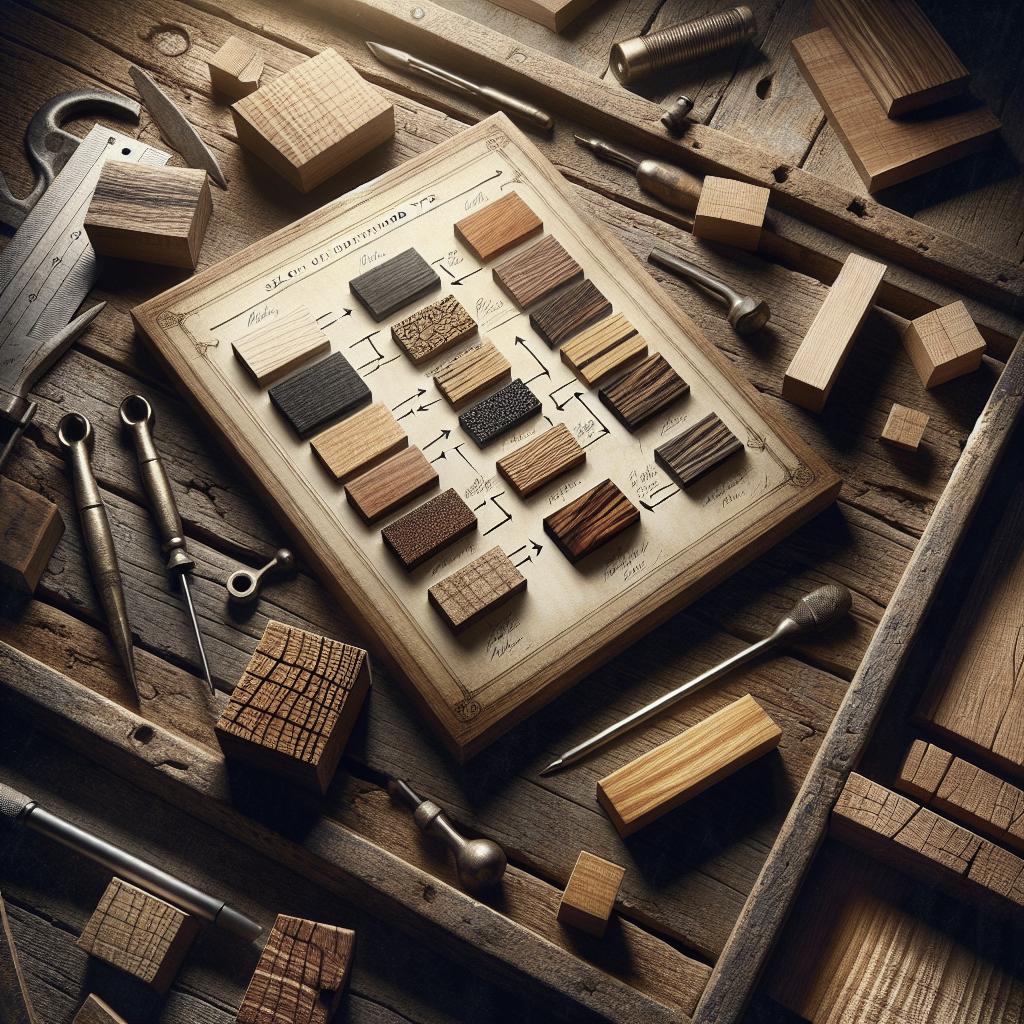“`html
Efficient Execution of Complex Woodworking Joinery
Woodworking joinery has evolved into a fine craft requiring precision and skill, especially when it involves complex techniques. This guide delves into some of the most common joinery methods, discussing their applications and efficiency in construction. From the simple butt joint to the intricate dovetail joint, each technique offers unique advantages depending on the project requirements and the craftsman’s expertise. Here, we explore twelve types of woodworking joinery, providing insights into how these methods can be executed efficiently for high-quality results.
1. BUTT JOINT
The butt joint is perhaps the most basic form of woodworking joinery, where two pieces of wood are simply butted together. Its simplicity is its biggest advantage, making it a popular choice for simple frame constructions. However, its lack of structural strength means it’s mostly used in light applications.
To execute a butt joint efficiently, ensure the wood pieces are cut smoothly and accurately. This minimizes the gaps and ensures a snug fit. Reinforcement techniques such as dowels or screws are often used to enhance the joint’s strength.
While the butt joint serves its purpose within limited contexts, incorporating adhesives like wood glue can further stabilize the joint, providing more durability for light to moderate applications.
2. POCKET-HOLE JOINERY
Pocket-hole joinery uses drilled holes to join pieces of wood. It’s an efficient method for creating a strong joint without requiring complex skills or tools. This technique is often used in cabinetry and furniture where aesthetics are also important, as it allows the screws to be hidden.
Achieving maximum efficiency with pocket-hole joinery involves precise drilling. Using a jig can ensure accuracy, preventing wood splitting and ensuring a tight, secure joint. The ease of use and strong result makes it ideal for many DIY projects.
While pocket holes are a great solution for quick assembly, consider using dowels or plugs to cover the holes for an improved visual appeal and structural integrity.
3. BISCUIT JOINT
Biscuit joinery involves the use of oval-shaped pieces of wood, or biscuits, inserted into slots cut into adjoining wood pieces. The biscuits expand when glue is applied, creating a strong bond. This method is favored for its alignment advantage, particularly in tabletops and panel glue-ups.
Executing an efficient biscuit joint often relies on having a reliable biscuit joiner, ensuring that slots are precisely aligned with each other. Proper biscuit sizing and spacing are crucial for maintaining overall structural strength.
While biscuits add moderate strength, they excel in improving alignment and are best used in conjunction with another fastening method or system to address structural weaknesses in larger projects.
4. FLOATING MORTISE AND TENON
The floating mortise and tenon joint utilizes a loose tenon that fits into matching mortises on both workpieces. This technique offers flexibility and ease of repair, as the tenon can be replaced if needed. It’s a favorite in high-quality furniture making due to its strength and durability.
For efficient implementation, accurately measuring and cutting mortises is key. Maintaining a consistent and snug fit between mortise and tenon ensures a solid joint. Specialized jigs can help streamline this process and enhance precision.
This joint’s adaptability makes it particularly useful in repair work and scenarios where traditional joints may cause alignment issues due to wood movement or distortion over time.
5. RABBET JOINT
A rabbet joint, often used in cabinet work, involves recessing or grooving one piece of wood to allow another piece to fit into it. This joint provides more gluing surface compared to a butt joint, thus offering enhanced stability.
Efficiency in creating rabbet joints is achieved through accurate measurements and clean cuts. Power tools such as routers or table saws can speed up the process and enhance accuracy. Ensuring a perfect fit is essential for achieving the joint’s full structural potential.
Rabbet joints excel in projects requiring both functional and decorative features, making them ideal in casing and shelving constructions.
6. DADO JOINT
The dado joint is made by cutting a slot or trench across the grain of a wood board that another piece fits into. It’s widely used in shelving, cabinetry, and sturdy framework because of its strength and ease of assembly.
Precision in cutting the dado slot is essential for the joint to be firm and functional. Typically, the slot should match the width of the piece that will fit into it. Dado blades on table saws can greatly facilitate cutting these joints efficiently.
Enhancing a dado with glue or screws can further increase its holding capacity, making them ideal for load-bearing applications.
7. LAP JOINT
The lap joint involves overlapping two pieces of wood and providing a significant gluing surface area, which makes it a strong joint for building frames and frameworks. It’s a simple yet effective joinery method.
The efficiency of a lap joint rests in precise cutting and alignment. Using a saw or chisel, ensure both pieces have matching laps that fit evenly together without excessive gaps. Reinforcement can be achieved with nails or screws as needed.
Lap joints are versatile in their usage, making them an essential technique in any woodworker’s repertoire for both structural and decorative applications.
8. FINGER JOINT
Finger joints combine long, square fingers into interlocking pieces, offering both strength and aesthetic appeal. It’s used primarily in box-making and constructing long pieces from shorter lengths.
Efficiency in finger jointing comes down to precision cutting. Finger joints require meticulous alignment, so employing a jig is highly recommended to maintain uniformity across all joins.
Being both sturdy and visually appealing, finger joints are best utilized in projects requiring both functionality and design appeal, such as drawer fronts and decorative panels.
9. MORTISE AND TENON JOINT
The mortise and tenon joint is a timeless classic known for its superior strength, making it a fundamental technique in traditional woodworking and furniture design. The tenon, or protruding piece, fits snugly into the mortise, or recess.
Executing this joint efficiently involves careful cutting and chiseling to ensure a tight fit. Precision is crucial, as a loose fit can compromise the joint’s strength. Using a mortising machine can streamline the process and improve accuracy.
Mortise and tenon joints are ideal for high-strength structures such as tables and chairs, where durability is a priority.
10. BRIDLE JOINT
The bridle joint is similar to the mortise and tenon, but instead of a mortise, it involves cutting a slot all the way through one of the pieces. It is useful in frame construction where more surface area is desirable for adhesives.
For efficient bridle joint execution, accurate measurement and sawing techniques are paramount. The use of a bandsaw or table saw can facilitate precise cuts and enhance the overall fit of the joint.
Its simplicity and strength make it excellent for outdoor furniture and structures where wood expansion may be an issue.
11. TONGUE AND GROOVE JOINTS
Tongue and groove joints are designed to fit together seamlessly, typically used in flooring, paneling, and similar applications. The adaptable nature of this joint allows it to provide a tight seal and stable connection.
Efficiency is achieved by ensuring the tongue fits snugly into the groove; mismatches can result in gapping. A router or specialized table saw setup can create these joints efficiently and consistently.
The solid interlocking nature of tongue and groove joints provides excellent support for applications involving large areas that demand a smooth surface finish.
12. DOVETAIL JOINT
The dovetail joint is revered for its strength and beauty, frequently used in drawer and box construction. The tails and pins interlock snugly, providing a strong and durable bond without the need for additional fasteners.
Precision and technique are vital for dovetail joints; using a dovetail jig can help in achieving consistently accurate cuts. Machine-made joints offer uniformity, while hand-cut dovetails can add a unique, personalized touch to woodworking projects.
It’s an ideal method when both functionality and decorative craftsmanship are desired, particularly for heirloom-quality furniture and fixturing.
Future Prospects
| Joinery Technique | Application | Tools Required | Strength |
|---|---|---|---|
| Butt Joint | Light frameworks | Saw, screwdriver | Low |
| Pocket-Hole Joinery | Cabinetry, furniture | Drill, pocket-hole jig | Moderate |
| Biscuit Joint | Tabletops, panels | Biscuit joiner | Moderate |
| Floating Mortise and Tenon | Fine furniture | Router, chisels | High |
| Rabbet Joint | Cabinet work | Router, table saw | Moderate |
| Dado Joint | Shelving, cabinetry | Table saw, dado blade | High |
| Lap Joint | Frames, frameworks | Saw, chisel | High |
| Finger Joint | Boxes, long pieces | Jig, saw | Very High |
| Mortise and Tenon Joint | Tables, chairs | Chisels, mortise machine | Very High |
| Bridle Joint | Frames, outdoor furniture | Saw, bandsaw | High |
| Tongue and Groove Joints | Flooring, paneling | Router, table saw | High |
| Dovetail Joint | Drawers, boxes | Dovetail jig, saw | Very High |
“`


